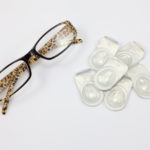By Vittorio Mena, OD, MS

Feb. 9, 2022
Patients love the flexibility of being able to wear glasses or contact lenses. Sometimes they will be frustrated that they cannot wear contact lenses, but, for one reason or another, won’t bring this up on their own during their exam. That silence will make it impossible for you to address the problem causing contact lens discomfort, and ultimately, may lead the patient to drop out of contact lenses entirely.
If you can prevent a patient from dropping out of contact lenses, it is a win-win for patient and practice. The patient wins by being able to continue wearing contacts. The practice wins by having a patient who is more likely to return each year for an annual exam to renew their prescription and purchase contacts, glasses and sunwear at the same time.
There is a significant financial incentive to keeping patients in their contact lenses. Let’s say we average 15 patients a day, and work only five days a week at the office, seeing 75 patients a week. That is 300 patients a month. If you were to charge, for example, $100, for a contact lens insertion and removal evaluation, and have 100 out of those 300 new patients introduced to contact lenses every month, the office would generate $10,000 a month. That equals $120,000 a year. And that is not even including selling contact lenses in the practice, which would generate more money. If all, or most, of those patients stay in their lenses and return every year for an exam, contact lens prescription renewal and product purchase, you are generating substantial ongoing revenues.
With so much in patient satisfaction and profitability dependent on keeping patients in their lenses, it is worth taking the actions necessary to prevent dropouts. Here is what I have discovered to be the most important things an OD can do to keep patients in their contacts.
Are You Asking CL Patients Open-Ended Questions?
When we take a history of a patient, we are figuring out their visual needs at work, along with their leisure-time activities. In addition, I ask the patient how often they wear their contacts, how long they wear their contacts on the days they are worn, and whether there are specific activities they wear their contacts for.
We ask open-ended questions in our office to learn whether a patient is truly happy in a lens. It is not enough to ask a patient, “How are you doing with your contacts?” Most will respond, “fine,” which we know often truly means “feelings I’m not expressing.” If a patient is complaining of dryness to their eyes while wearing contact lenses, I usually try switching them to a different modality, such as a daily disposable lens, so they can see if their discomfort symptoms disappear after a few days. Open-ended questions give you the opportunity to discover discomfort that this kind of simple solution can successfully address.
How Good Are You At Educating Patients About All Their CL Options?
Patients are constantly upgrading technological devices like phones, tablets, laptops and televisions, but when it comes to contact lenses, they are sadly too often wearing lenses featuring outdated technology.
The first reason patients drop out of contacts is because we are not educating or recommending a better modality to them. ODs often have the mindset of, “if it ain’t broke don’t fix it.” When a patient is in a lens made of outdated material, which they also happen to be over-wearing and sleeping in, it’s not surprising that the lenses become uncomfortable and unwearable. Their eyes begin to feel dry and irritated when wearing their lenses.
There are always going to be patients who want the most inexpensive lenses, regardless of how outdated the material in their lenses are. However, it is up to us to educate even those patients about other, better options. We should never prejudge a patient on what they are willing to spend on a product. And, fortunately, there are newer monthly lenses on the market that feel like nothing is on the eye. This allows you to easily provide a great option for patients in need of a better lens, who tell you they are not able to afford a daily disposable.
How Good Are You at Prescribing & Fitting Multifocal CLs?
Another major reason patients drop out of contact lenses is because their lenses no longer allow them to see both near and far. Patients may not know that multifocal contact lens options exist, and that these options often allow a person with presbyopia to continue wearing contact lenses with little-to-no need for reading glasses.
Other Articles to Explore
If you follow the fit guide for each multifocal lens brand, your patient will most likely be successfully fit in the lens and keep wearing it. When a multifocal doesn’t work for a patient, the most common cause of the problem is the doctor did not follow the fit guide for the particular lens the patient was prescribed. Another reason a patient is not successful in multifocals is because their prescription is too high for a standard multifocal, so that they require a specialty fit.
It’s worth taking the time to meet with your contact lens vendors to become better educated about all of the multifocal lens options for your patients, including which options would be best for which patients. Your vendor partners can also provide education and guidance on fitting the multifocal lenses you purchase from them.
Are You Letting Astigmatic Patients Know About Toric Lenses?
Patients with astigmatism may have been told many years ago that contact lenses are either not an option for them, or necessarily uncomfortable if they do decide to wear them.
Thanks to new designs and materials in toric lenses, there is usually no reason an astigmatic patient can’t wear contact lenses and be satisfied in those lenses. I take the time to let my astigmatic patients know that contact lenses are an option for them, and that there is more than one lens they could try that probably would be a good match for their eyes.
 Vittorio Mena OD, MS, is the sports vision director with Optical Academy. To contact him: menavitt@gmail.com
Vittorio Mena OD, MS, is the sports vision director with Optical Academy. To contact him: menavitt@gmail.com





















